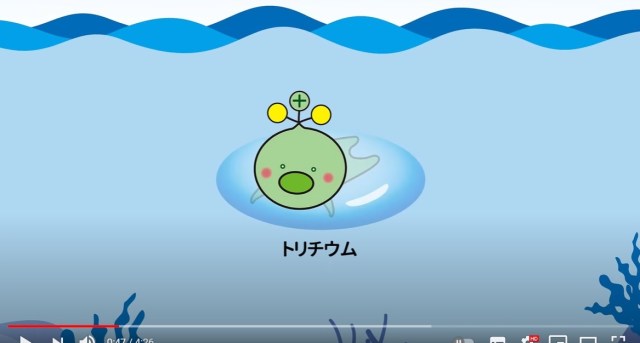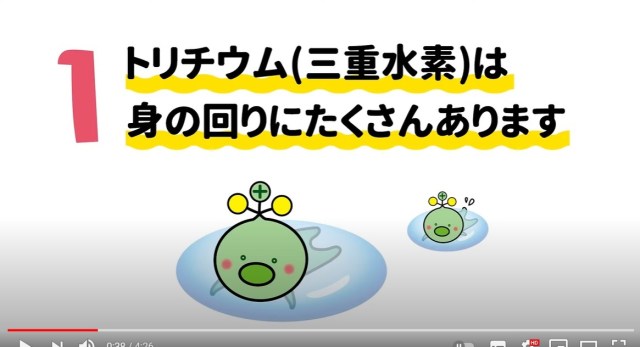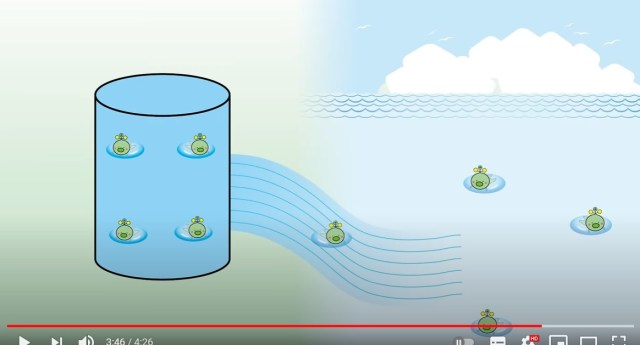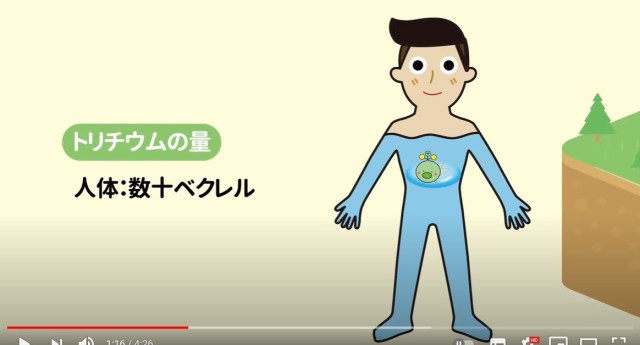
Video released on same day approval is granted for waste water project at Fukushima nuclear power plant.
As the branch of the Japanese government tasked with dealing with the effects of the 2011 Tohoku earthquake and tsunami, the responsibilities of the Reconstruction Agency include keeping people informed about health and safety issues. This being Japan, cute illustrated characters being part of public awareness campaigns usually doesn’t surprise anyone, but it’s a different story with a new video and pamphlet the Reconstruction Agency just put out.
Those cute little green guys, who look like something you might find in the latest Pokémon DLC package, are meant to represent tritium, a radioactive hydrogen isotype. The video and pamphlet were released on Tuesday, which, not coincidentally, was the same day the Japanese government approved a plan to dispose of treated waste water from the Fukushima Daiichi Nuclear Power Plant, which still contains tritium, by dumping it into the ocean.
Support for the plan is far from universal among the general population and business groups such as commercial fishing operations. However, proponents argue that the measure is both necessary and harmless. Radiated water at the Fukushima Daiichi Nuclear Power Plant is being stored in tanks on the site as it is treated, with the roughly 1,000 tanks currently in use representing a volume of water that could fill the Tokyo Dome sports stadium. All of the site’s storage tanks are projected to be full by the end of 2022, and operator TEPCO (Tokyo Electric Power Company) is not legally allowed to build off-site storage containers.
The agency says that the water to be dumped into the ocean has been treated to remove all of its radioactive material aside from tritium, which as an isotope of hydrogen presents a special problem when attempting to separate it from water. In an attempt to put people’s minds at ease, the video/pamphlet point out that tritium is weak enough that it can’t penetrate human skin, and can already be found in rainwater, seawater, tap water, and even the human body, where it hasn’t been found to be harmful in sufficiently small quantities. The awareness campaign also stresses that tritium does not accumulate in the human body, but is passed out as part of liquid human waste.
The Reconstruction Agency’s plan has the support of not only the Japanese government, but the International Atomic Energy Agency as well. The water will be further diluted before dumping to a tritium concentration that’s a mere 1/7 of the amount permissible for drinking water as per World Health Organization Standards, and it’s not like the plan is to just tip over all 1,000 containers all at once, as the release into the ocean will be paced slowly enough to take several decades to complete. The Atomic Energy Agency also adds that dumping treated water that still contains tritium into the ocean is a common practice at many nuclear power plants as part of their regular, non-emergency operations.
Still, the Reconstruction Agency explaining the plan while representing the contentious radioactive material as a cute creature isn’t sitting well with critics, whose online reactions have included:
“The Reconstruction Agency sure was quick to make a…character for image control purposes. This country has gone off the deep end.”
“That agency ain’t right in the head. They should replace the whole lot of ‘em.”
“Crazy…changing the image of something doesn’t mean it’s suddenly safe.”
It’s worth noting that despite many social media commenters referring to the illustrated tritium as a “mascot character,” with some even dubbing it “Tritium-kun,” the Reconstruction Agency itself hasn’t given the illustration a name or tried imbuing it with any personality traits or endearing characteristics beyond its appearance. “Our primary intent is to create a sense of familiarity [with the substance],” said a representative from the agency. “Our goal was a representation that was neither ‘good’ nor ‘bad,’ but intermediate.”
However, with Japanese society’s long-standing inclination to associate cuteness with godliness, it shouldn’t have been hard to foresee that some people would take the illustration as an attempt to frame tritium itself in a positive light, and the Reconstruction Agency could have saved itself some explanations by taking another route visually.
Source: Reconstruction Agency, Tokyo Shimbun via Otakomu, Twitter, Australian Broadcasting Corporation, Wall Street Journal, Forbes
Images: YouTube/復興庁/Reconstruction Agency
● Want to hear about SoraNews24’s latest articles as soon as they’re published? Follow us on Facebook and Twitter!




 TEPCO in hot water for use of tasteless hashtag in recent tweet about Fukushima Nuclear Plant
TEPCO in hot water for use of tasteless hashtag in recent tweet about Fukushima Nuclear Plant Outburst by Japanese minister at press conference overshadowed by…his Eva anime tie
Outburst by Japanese minister at press conference overshadowed by…his Eva anime tie Common ramen ingredient found highly effective at clearing up radioactive contamination
Common ramen ingredient found highly effective at clearing up radioactive contamination Fukushima bottled water wins Gold Quality Award in the internationally coveted Monde Selection
Fukushima bottled water wins Gold Quality Award in the internationally coveted Monde Selection U.S. military in Japan bulk buys Japanese scallops as China’s Japanese seafood ban continues
U.S. military in Japan bulk buys Japanese scallops as China’s Japanese seafood ban continues Red light district sushi restaurant in Tokyo shows us just how wrong we were about it
Red light district sushi restaurant in Tokyo shows us just how wrong we were about it Sandwiches fit for a sumo served up in Osaka【Taste Test】
Sandwiches fit for a sumo served up in Osaka【Taste Test】 McDonald’s new Happy Meals offer up cute and practical Sanrio lifestyle goods
McDonald’s new Happy Meals offer up cute and practical Sanrio lifestyle goods Tokyo Tsukiji fish market site to be redeveloped with 50,000-seat stadium, hotel, shopping center
Tokyo Tsukiji fish market site to be redeveloped with 50,000-seat stadium, hotel, shopping center Starbucks Japan adds a Motto Frappuccino to the menu for a limited time
Starbucks Japan adds a Motto Frappuccino to the menu for a limited time Japanese ramen restaurants under pressure from new yen banknotes
Japanese ramen restaurants under pressure from new yen banknotes Beautiful Red and Blue Star luxury trains set to be Japan’s new Hokkaido travel stars
Beautiful Red and Blue Star luxury trains set to be Japan’s new Hokkaido travel stars Akihabara pop-up shop sells goods made by Japanese prison inmates
Akihabara pop-up shop sells goods made by Japanese prison inmates Family Mart makes matcha dreams come true with new lineup of strong green tea sweets in Japan
Family Mart makes matcha dreams come true with new lineup of strong green tea sweets in Japan We tried Korea’s way-too-big King Tonkatsu Burger at Lotteria 【Taste Test】
We tried Korea’s way-too-big King Tonkatsu Burger at Lotteria 【Taste Test】 All-you-can-drink Starbucks and amazing views part of Tokyo’s new 170 meter-high sky lounge
All-you-can-drink Starbucks and amazing views part of Tokyo’s new 170 meter-high sky lounge More foreign tourists than ever before in history visited Japan last month
More foreign tourists than ever before in history visited Japan last month French Fries Bread in Tokyo’s Shibuya becomes a hit on social media
French Fries Bread in Tokyo’s Shibuya becomes a hit on social media Studio Ghibli releases new action figures featuring Nausicaä of the Valley of the Wind characters
Studio Ghibli releases new action figures featuring Nausicaä of the Valley of the Wind characters New private rooms on Tokaido Shinkansen change the way we travel from Tokyo to Kyoto
New private rooms on Tokaido Shinkansen change the way we travel from Tokyo to Kyoto Starbucks reopens at Shibuya Scramble Crossing with new look and design concept
Starbucks reopens at Shibuya Scramble Crossing with new look and design concept Studio Ghibli glasses cases let anime characters keep an eye on your spectacles
Studio Ghibli glasses cases let anime characters keep an eye on your spectacles Beautiful Ghibli sealing wax kits let you create accessories and elegant letter decorations【Pics】
Beautiful Ghibli sealing wax kits let you create accessories and elegant letter decorations【Pics】 Studio Ghibli releases Kiki’s Delivery Service chocolate cake pouches in Japan
Studio Ghibli releases Kiki’s Delivery Service chocolate cake pouches in Japan New definition of “Japanese whiskey” goes into effect to prevent fakes from fooling overseas buyers
New definition of “Japanese whiskey” goes into effect to prevent fakes from fooling overseas buyers Our Japanese reporter visits Costco in the U.S., finds super American and very Japanese things
Our Japanese reporter visits Costco in the U.S., finds super American and very Japanese things Studio Ghibli unveils Mother’s Day gift set that captures the love in My Neighbour Totoro
Studio Ghibli unveils Mother’s Day gift set that captures the love in My Neighbour Totoro New Japanese KitKat flavour stars Sanrio characters, including Hello Kitty
New Japanese KitKat flavour stars Sanrio characters, including Hello Kitty New Pokémon cakes let you eat your way through Pikachu and all the Eevee evolutions
New Pokémon cakes let you eat your way through Pikachu and all the Eevee evolutions Disney princesses get official manga makeovers for Manga Princess Cafe opening in Tokyo
Disney princesses get official manga makeovers for Manga Princess Cafe opening in Tokyo Sales of Japan’s most convenient train ticket/shopping payment cards suspended indefinitely
Sales of Japan’s most convenient train ticket/shopping payment cards suspended indefinitely Sold-out Studio Ghibli desktop humidifiers are back so Totoro can help you through the dry season
Sold-out Studio Ghibli desktop humidifiers are back so Totoro can help you through the dry season Japanese government to make first change to romanization spelling rules since the 1950s
Japanese government to make first change to romanization spelling rules since the 1950s Ghibli founders Toshio Suzuki and Hayao Miyazaki contribute to Japanese whisky Totoro label design
Ghibli founders Toshio Suzuki and Hayao Miyazaki contribute to Japanese whisky Totoro label design Doraemon found buried at sea as scene from 1993 anime becomes real life【Photos】
Doraemon found buried at sea as scene from 1993 anime becomes real life【Photos】 Tokyo’s most famous Starbucks is closed
Tokyo’s most famous Starbucks is closed One Piece characters’ nationalities revealed, but fans have mixed opinions
One Piece characters’ nationalities revealed, but fans have mixed opinions We asked a Uniqlo employee what four things we should buy and their suggestions didn’t disappoint
We asked a Uniqlo employee what four things we should buy and their suggestions didn’t disappoint Princesses, fruits, and blacksmiths: Study reveals the 30 most unusual family names in Japan
Princesses, fruits, and blacksmiths: Study reveals the 30 most unusual family names in Japan Take a tour of the Fukushima Daiichi Nuclear Power Plant seven years after the disaster 【Video】
Take a tour of the Fukushima Daiichi Nuclear Power Plant seven years after the disaster 【Video】 Haruki Murakami’s solution to the nuclear power debate in Japan: Actually call it “nuclear power”
Haruki Murakami’s solution to the nuclear power debate in Japan: Actually call it “nuclear power” Discovery of unregistered radioactive substance in Japanese university shocks students
Discovery of unregistered radioactive substance in Japanese university shocks students Japan’s hydrogen fuel cell stations begin to open, but are they worth the switch?
Japan’s hydrogen fuel cell stations begin to open, but are they worth the switch? North Korea claims successful hydrogen bomb test, world very skeptical
North Korea claims successful hydrogen bomb test, world very skeptical First worker to die from Fukushima radiation exposure officially recognized by Japan’s government
First worker to die from Fukushima radiation exposure officially recognized by Japan’s government A vision of the future? We can’t take our eyes off Shimizu Corporation’s “Ocean Spiral” design
A vision of the future? We can’t take our eyes off Shimizu Corporation’s “Ocean Spiral” design South Korean university develops toilet that converts poop to power and pays you for “deposits”
South Korean university develops toilet that converts poop to power and pays you for “deposits” Japan’s secret garbage problem–and what you can do to help
Japan’s secret garbage problem–and what you can do to help Real Fullmetal Alchemists: Kyoto University team fuses all 8 precious metals into single alloy
Real Fullmetal Alchemists: Kyoto University team fuses all 8 precious metals into single alloy Toyota’s hydrogen fuel cell powered car ready for sale this December
Toyota’s hydrogen fuel cell powered car ready for sale this December New onsen facility in the heart of Tokyo’s business district to be ready for Olympics
New onsen facility in the heart of Tokyo’s business district to be ready for Olympics Johnny’s talent agency announces name change, dismantling, and upcoming new agency formation
Johnny’s talent agency announces name change, dismantling, and upcoming new agency formation Moving video commemorates anniversary of the 2011 Tohoku earthquake and tsunami in Japan
Moving video commemorates anniversary of the 2011 Tohoku earthquake and tsunami in Japan Disaster-struck region aims to increase tourism by bringing ALL region-exclusive Pokémon to Japan
Disaster-struck region aims to increase tourism by bringing ALL region-exclusive Pokémon to Japan U.S. military personnel launch US$5 billion lawsuit against Tokyo Electrical Power Company
U.S. military personnel launch US$5 billion lawsuit against Tokyo Electrical Power Company
Leave a Reply